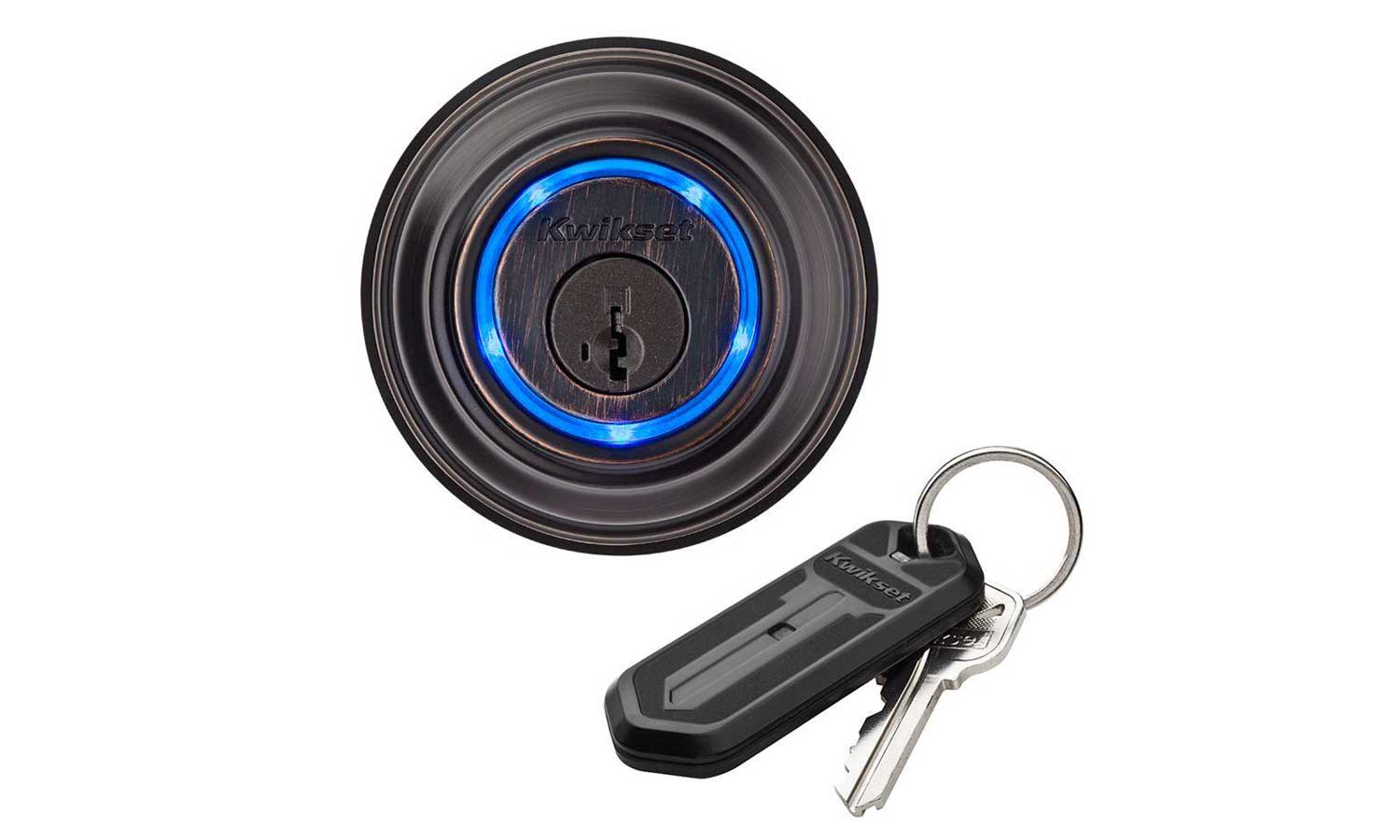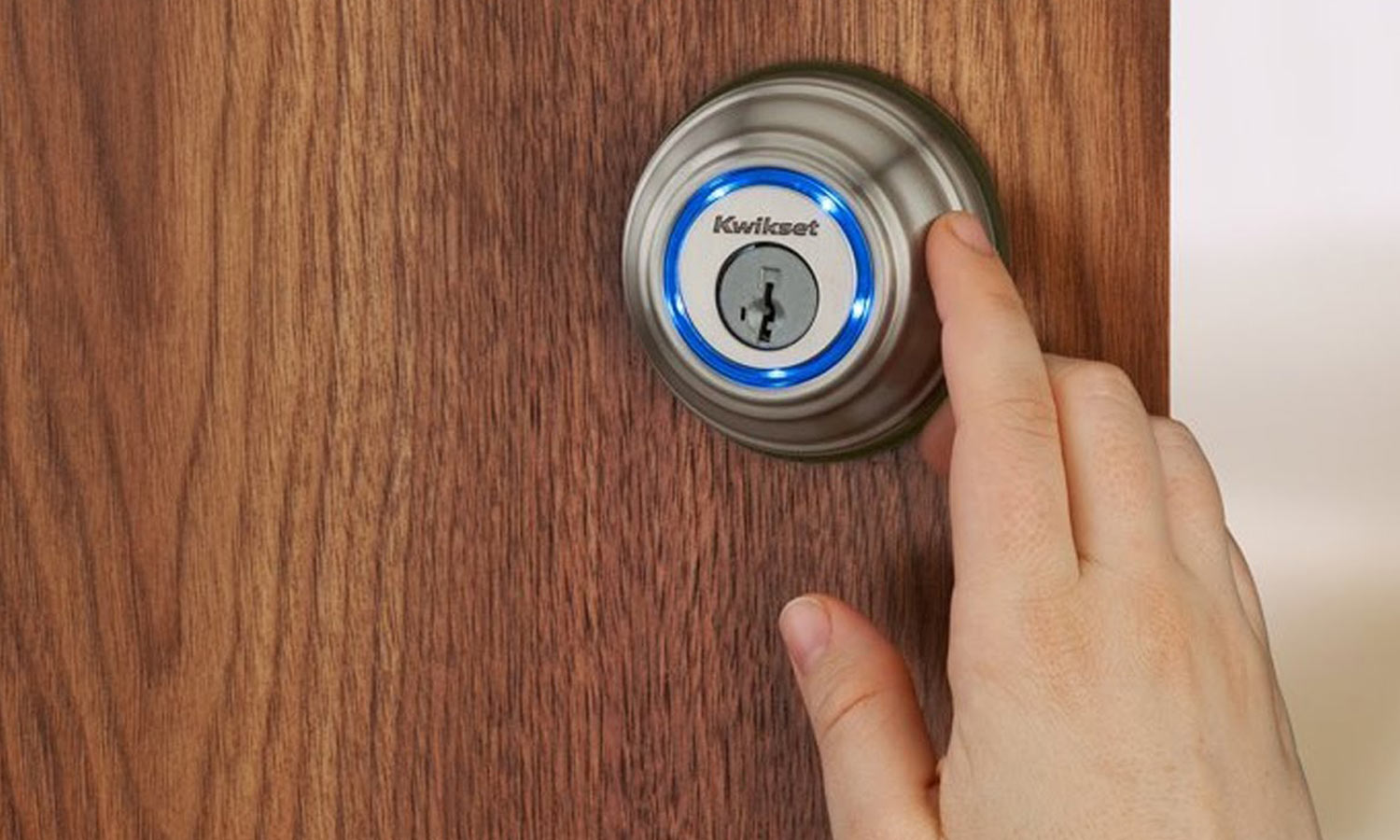Tom's Guide Verdict
No key required: Simply touch the Kwikset Kevo to unlock this deadbolt.
Pros
- +
Can use smartphone or key fob for hands-free unlocking
- +
Colored status lights
- +
Sleek iOS app
- +
Works with Nest
Cons
- -
Doesn't work with all Android devices
- -
Only works with a few smart home systems
- -
Extra codes cost $1.99 each
Why you can trust Tom's Guide
Smart door locks are gradually making their way into smart home technology. These secure, tech-savvy home deadbolts often give you remote access to your home, and sometimes communicate with other smart home devices.
The Kwikset Kevo Bluetooth Deadbolt takes this concept to a new level. Just keep your smartphone (or an electronic key fob) on you, and simply touch the deadbolt with your finger to unlock your door. Finally, a solution to the age-old problem of fumbling for your keys while juggling armloads of groceries! The Kevo will cost you a pretty penny for this cool feature, but the product offers solid security and control via a smartphone app.
Design
From the outside, the Kevo looks like a nondescript deadbolt. It's round in shape with a basic design, and available in Satin Nickel, Venetian Bronze or Lifetime Polished Brass finishes. I found the nickel model I tested to be quite handsome, yet inconspicuous.

Surrounding the keyhole is a lighted ring that flashes different colors when you touch the lock. The ring flashes blue anytime you touch the lock face, green when you unlock it, red when an attempt is rejected, and yellowish when you lock the Kevo behind you. The inside portion of the lock has a long metal-backed panel with a glossy black screen at the top and a regular key entry toward the bottom.
Installation
Installing the Kevo lock was fairly painless. In my case, all I needed was a screwdriver and measuring tape. The lock comes with several sets of hardware, since the Kevo fits different door sizes. This can be confusing, but Kwikset provides a helpful installation video on its website that allowed me to determine exactly which pieces I needed. After weeding through the extra hardware, it took me about 20-25 minutes to install the deadbolt.

Kevo is compatible with most iOS devices (the iPhone 4s and later, 5th-gen iPod Touch and 3rd-gen iPad), but compatibility with Android devices is limited to those running Android 5.0 or later with Bluetooth Low Energy (BLE) chips — and even then, a phone may not be compatible. A full list of compatible devices can be found here.
The app installed smoothly on my Samsung Galaxy S6, and I filled in a few lines of information to quickly set up a new Kevo account. Once I had confirmed my email address, I navigated through Kevo's basic yet simple-to-use app to add my phone as an eKey.
MORE: Best Smart Locks
Under the "My Locks & eKeys" tab, I clicked the "+" button and followed the app's directions. First, I slid up the back panel of the inside padlock to reveal the Kevo's battery pack. Then I pressed a button labeled "program" on the battery panel, and held my phone against the back panel for a few seconds. The app on my phone made the connection pretty quickly. My phone was set up as an eKey in about 10 minutes flat.
Performance
Kevo's smartphone app runs in the background, so you don't have to open it before entering your home, but it does mean that the Bluetooth setting on your phone has to be on all the time. The app lets you view lock history, set up or disable eKeys, and see who is using the lock.
Be judicious in handing out those eKeys, however, as each one (after the two included with your lock) will set you back $1.99, or about the cost of having a physical key copied. It leaves a slightly sour taste in my mouth to have to pay for a simple code.
Tech geek that I am, I was pretty excited to test out the Kevo lock's special finger-unlock. I had my phone on me and was prepared to touch the locked padlock and watch my fingers magically unlock the door. I touched the light ring, but it just flashed blue for a few seconds, then red, then … nothing.
Giving a spare key to friends or family visiting from out of town is as simple as sending them an email.
After experimenting, I found that my smartphone needed to be within a foot — 2 feet, max — for the lock to work properly. Once I learned to finesse the lock, the end result was very satisfying — the lock smoothly whirled and clicked, the light ring flashed blue, then green, and beeped twice.
There is a small delay between touching the lock and the mechanism actually opening, but not such a long lapse that you'd have to put down your groceries. It's also convenient to lock the door behind you by tapping the Kevo on your way out — again with a satisfying whir, beep and flashing yellow light.

The Kevo app conveniently allows you to create as many "guest" eKeys as you want. Giving a spare key to friends or family visiting from out of town is as simple as sending them an email, provided they have a smartphone that can run the app. However, guest eKeys last only 24 hours, after which they're automatically deleted, so it's a less-than-practical option if the guest is visiting for more than a day.
With eKeys, you can set time constraints so that the neighbor watering your plants while you're on vacation only enters your house when he's supposed to. (And through the app, you can make sure he locked up afterward.)
The only downside to guest eKeys is that the recipients must have the Kevo app on their devices to use it. Luckily, Kwikset has a way around this drawback, with a key-fob option that functions as a smart device would. One fob comes included with the Kevo, with the option to purchase more for $25 each.
Security
With the Kevo, since you must have the eKey to open the lock, there is no risk of a burglar hacking into your lock and opening it remotely.
The range of an eKey is also quite short, so there's no risk of the door being unlocked if, say, you leave your phone at home. Your phone has to be pretty much right at the door to work properly.

Kevo is able to determine whether the lock user is inside or outside of the home before granting access, and also boasts PKI encryption to keep the mobile and Web apps secure. Finally, if for some reason you are unable to use an eKey or the fob, the Kevo is equipped with a good old standard key lock, with the long-time brand's "superior picking resistance." The lock is certified for BMHA Level 2, the second-highest possible security rating.
Smart Home Compatibility
As it can only connect via Bluetooth, the Kevo doesn't work with most smart home systems. The one exception is that the Kevo will work with Nest Labs' smart home devices. The deadbolt communicates with Nest devices to tell them when you come or go into your home, so the Nest Learning Thermostat can adjust your home-temperature preferences. However, the second-generation Kevo, available later in 2016, will work with the Ring Video Doorbell, Honeywell Connected Wi-Fi Thermostats and Android Wear.
Kwikset also offers the $69 Kevo Plus, an adapter that connects the lock to the Internet via your Wi-Fi network. With this device, you can remotely control the lock from your smartphone, and receive alerts whenever the unit is locked or unlocked.
Bottom Line
A sharp-looking deadbolt with a deceptively plain outside face, the Kwikset Kevo is a smart lock with some intelligent features – most notably, the ability use your fingers to unlock the deadbolt. However, it works only with a limited number of Android devices, and, as of now, very few smart home systems. Despite these limitations, the Kevo is a great beginner smart lock – and, if you're like me, the futuristic green light and beep that let you in never get old.

Jason is a contributing writer for Tom's Guide based in the US with a focus on smart home and security coverage. He has reviewed smart locks, home-based security systems and password managers. As a result, both his home and personal computer are guarded like a fortress.
